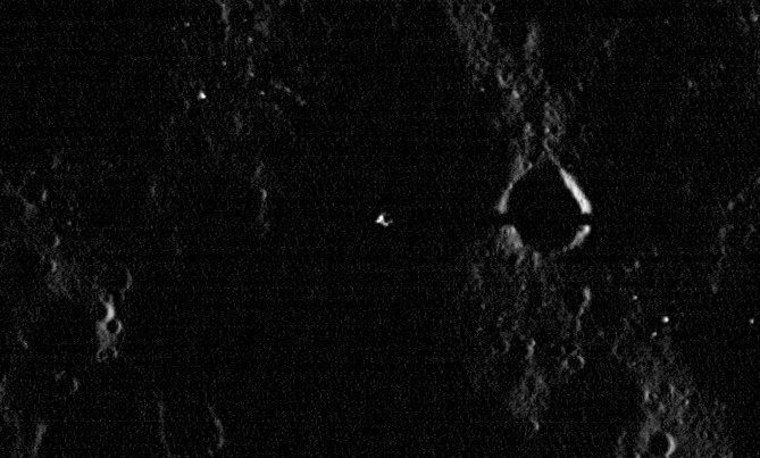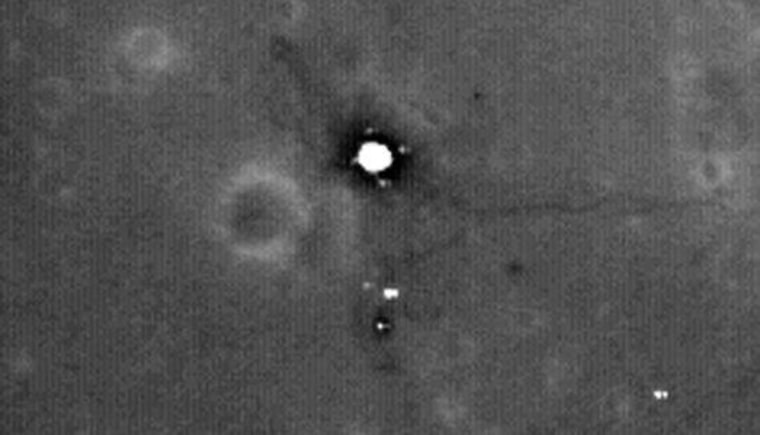Forty-three years ago today, Apollo 11 astronauts Neil Armstrong and Buzz Aldrin were on the moon for just 21 hours and 36 minutes, but thanks to a new NASA website, you can see how the lighting at their landing site changes over the course of the two-week-long lunar day.
This week, the team behind the camera on NASA's Lunar Reconnaissance Orbiter unveiled an online viewer that combines imagery at different sun angles for each of the Apollo landing sites, from sunrise to sunset. Such images have been released regularly for the past three years, but it's way cooler to see them presented with a slider that lets you see the shadows shorten and lengthen as the day wears on. You can also click buttons to add labels for the artifacts left at each site, to trace the paths of the astronauts' moonwalks, or just to get your bearings.
A murky view of the Apollo 11 site, captured by LRO just before lunar sunset, served as this week's "Where in the Cosmos" picture puzzle on the Cosmic Log Facebook page. I thought it was interesting to see the last rays of the day reflected off the very top of the Eagle lunar module's descent stage, producing a bright spot at the very center of the image. You can also see how the lunar module's shadow hitting the rim of the crater to the east of the landing site.

It didn't take long for Facebook followers to recognize what this mostly black picture showed. The first ones to register the right guesses — Mike Hardin, Brian McGraw, Wyatt Bates and James Aker — are eligible to receive celebratory pairs of 3-D glasses, courtesy of Microsoft Research's WorldWide Telescope team and yours truly. You can use your red-blue glasses to see 3-D views of the Apollo 11 site and lots of other space scenes.
The 43rd anniversary of any event is not usually that big of a deal, but today's "Dark Knight" shootings in Colorado left a lot of people looking for something positive to balance out all of the day's negativity. Apollo 11 provided that positivity, in 1969 and in 2012. I particularly liked the Twitter update from John Ryan: "News out of Colorado is grim, but today's also the anniversary of the first moon landing. Take heart, humanity can do amazing things, too."
No one knew that better than the late astronomer Carl Sagan. In Sagan's reflections on the Apollo missions, which endure in his book "Pale Blue Dot" as well as the Sagan Series of videos produced by Reid Gower, the sage marveled at the rare opportunity afforded by the Cold War space effort: "Once upon a time, we soared into the solar system. For a few years. Then we hurried back. Why? What happened? What was 'Apollo' really about?"
I can't watch the video without tears coming to my eyes. But at least they're not tears of grief.
More reflections on Apollo 11:
- Transterrestrial Musings: Evoloterra
- Bad Astronomy: What Apollo means to me
- Neil Armstrong still chooses to go to the moon
- Universe Today: The journeys of Apollo, on video
Alan Boyle is NBCNews.com's science editor. Connect with the Cosmic Log community by "liking" the log's Facebook page, following @b0yle on Twitter and adding the Cosmic Log page to your Google+ presence. To keep up with Cosmic Log as well as NBCNews.com's other stories about science and space, sign up for the Tech & Science newsletter, delivered to your email in-box every weekday. You can also check out "The Case for Pluto," my book about the dwarf planet and the search for new worlds.
